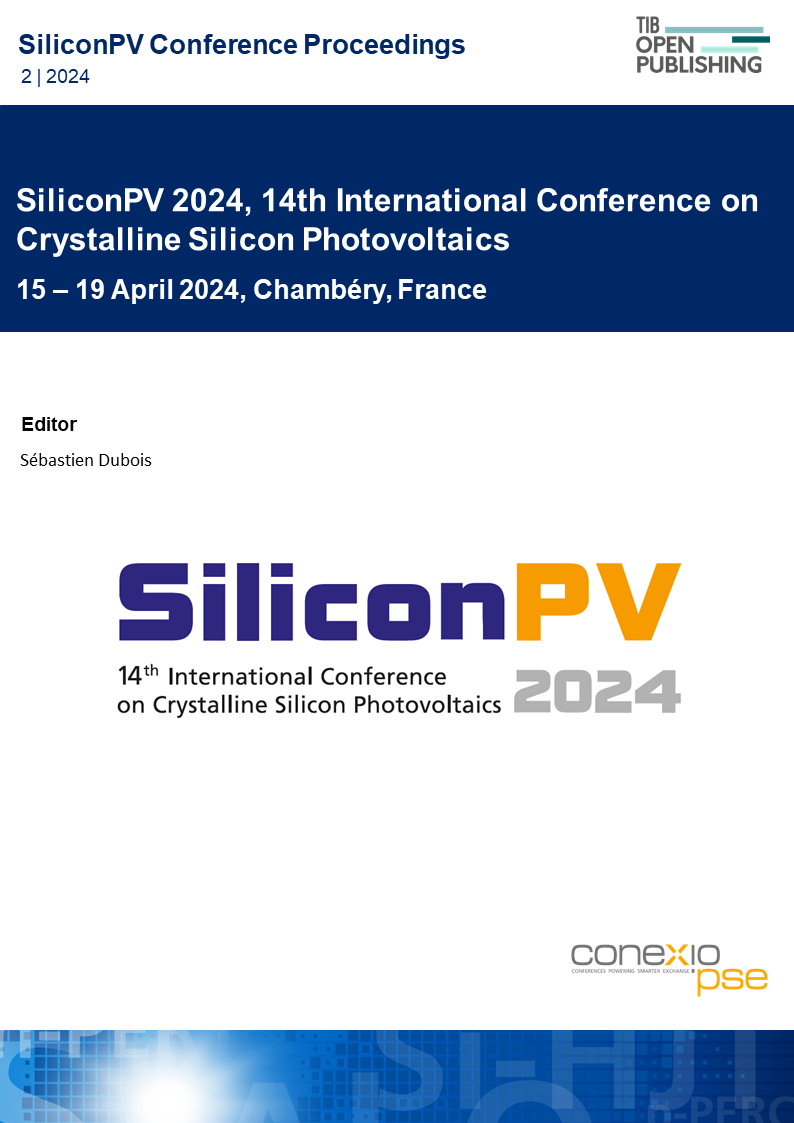Reduction of Scarce Materials in Silicon Heterojunction Solar Cells and Implications on the Performance in the Field
DOI:
https://doi.org/10.52825/siliconpv.v2i.839Keywords:
Heterojunction, Field Performance, Silver Consumption, Indium ConsumptionAbstract
In the first part of this work the potential to save silver for n-type silicon heterojunction solar cells was investigated. Cells were produced with varied frontside screen opening (30-50 µm). The groups were compared for efficiency at different irradiation levels and frontside silver laydown. For five busbar configuration large opening with low series resistance led to the highest efficiency for high irradiation around 1000 W/m² while for low irradiations all cells performed similarly. For busbarless cells lower silver laydown led to similar efficiency with slight advances for narrow screen opening. In summary cell technologies with small busbar-pitch are more tolerant for low-silver metallization. In the second part the impact of the transparent conductive oxide (TCO) was addressed. Silicon Heterojunction cells were produced with either ITO (indium tin oxide) only or an ITO-AZO-ITO (aluminium doped zinc oxide) stack, enabling an ITO reduction of about 50%, leading to a tolerable efficiency-drop of 0.3%. These internal samples were compared to industrial heterojunction-precursors (post ITO) with reference and low silver consumption frontside metallization. For both parts IV measurement showed that series resistance has a strong impact on efficiency but a rather small impact on low light-efficiency. Considering low light conditions TCO-precursor type with differences in passivation have a strong impact. On module level similar irradiation dependence of the efficiency was found and in temperature-dependent IV-measurements a positive impact of high-quality passivation on the temperature coefficients was found while an increase of the series resistance had a negative impact on the temperature dependence.
Downloads
References
1. International Technology Roadmap for Photovoltaic (ITRPV) Report (2022)
2. LONGi, “At 26.81%, LONGi sets a new world record efficiency for silicon solar cells”. https://www.longi.com/en/news/propelling-the-transformation/ (21.04.2023 accessed)
3. A. Bhambhani. “Germany’s TUV SUD Confirms Risen Energy Claim Of Achieving 23.89% Efficiency For Heterojunction Modules With 741W+ Output” https://taiyangnews.info/technology/risen-energy-hits-23-89-efficiency-for-hjt-modules/ (21.04.2023 accessed)
4. B. Hallam et al., “Challenges and Opportunities for Terawatt-Scale Deployment of n-Type Solar Cell Technology” SiliconPV, 2022, not published (yet)
5. E. Gervais et al., “Sustainability strategies for PV: framework, status and needs”, EPJ Photovolatics, 2021, DOI: 10.1051/epjpv/2021005
6. G. Deboutte, PV Magazine, “CEA-INES reduces silver consumption in M2 heterojunc-tion solar cell”. https://www.pv-magazine.com/2022/10/26/cea-ines-reduces-silver-consumption-in-m2-heterojunction-solar-cell/ (21.04.2023 accessed)
7. B. Litzenburger et al., „Low Light performance of Solar Cells and Modules”, EU PVSEC, 2014, DOI: 10.4229/EUPVSEC20142014-5CV.2.6
8. S. Pingel et al, “Low-Temperature Ag-Paste Screening for Silicon Heterojunction Solar Cells and Modules”, EUPVSEC, 2020, DOI: 10.4229/EUPVSEC20202020-2DV.3.17
9. S. Janke et al. “Approaches for SHJ Cells with Low or No Indium Content“, SiliconPV, 2022, not published (yet)
10. M. Dimer et al., “Potential of Sputtered AZO Layers for the Industrial Manufacturing of Hetero Junction Solar Cells“, WCPEC / EU PVSEC, 2022, 10.4229/WCPEC-82022-1DO.12.4
11. P. Schmid et al., „Reducing Indium Consumption in Silicon Hetero Junction Solar Cells with TCO Stack Systems of ITO and AZO“, IEEE, 2023, will be published, DOI: 10.1109/JPHOTOV.2023.3267175
Published
How to Cite
Conference Proceedings Volume
Section
License
Copyright (c) 2024 Sebastian Pingel, Ioan Voicu Vulcanean, Timo Wenzel, Winfried Wolke, Vasileios Georgiou-Sarlikiotis, Philipp Schmid, Henning Nagel, Ulli Kräling, Martin Bivour, Anamaria Steinmetz

This work is licensed under a Creative Commons Attribution 4.0 International License.
Funding data
-
Bundesministerium für Wirtschaft und Technologie
Grant numbers FKZ: 03EE1032
